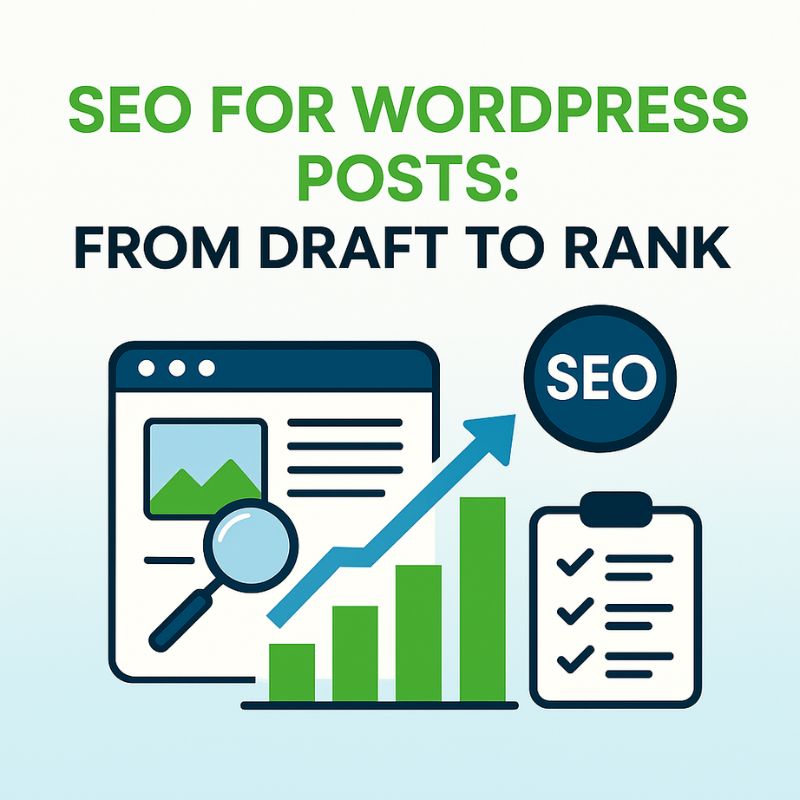SEO for WordPress Posts: From Draft to Rank

SEO for WordPress Posts: From Draft to Rank
Mastering SEO for WordPress Posts is one of the most powerful skills for bloggers, marketers, and business owners. However, without proper optimization, even great content fails to reach its audience. Therefore, this guide explains—step by step—how to transform a simple draft into a search-optimized article that attracts readers and ranks higher.
Why SEO for WordPress Posts Matters
WordPress powers a massive share of the web; as a result, competition is intense. Moreover, according to Google’s SEO Starter Guide, pages with clear structure, relevant keywords, and trustworthy links consistently perform better. In addition, if you start a WordPress blog, building SEO habits early ensures long-term growth.
Choosing the Right Keywords
Every optimization journey begins with keyword research. For example, if you cover Google Chrome Guide 2025, identify what users search for around speed, privacy, and features. Similarly, tools like Ahrefs and Ubersuggest reveal opportunities. Therefore, choose a balanced set of a focus term, variations, and LSI phrases.
Crafting Titles and Meta Descriptions
Titles and meta descriptions shape first impressions; consequently, they affect click-through rate. Keep your SEO title under 55 characters and your meta description under 154 characters. For instance, your Firefox Browser Guide 2025 shows how concise phrasing improves engagement.
Engaging Introductions for WordPress SEO
Open with a promise and place the focus term within the first 100 words. As a result, search engines immediately understand the topic. For clarity, mention SEO for WordPress Posts early, then transition into benefits, scope, and outcomes.
Structuring Content with Headings
Clear hierarchy improves readability and crawlability. In addition, it guides readers through your argument. Use H2 for main sections and H3 for supporting ideas. For example, in your article on Microsoft Edge 2025, consistent headings help users scan quickly.
Internal and External Linking for SEO
Links connect topics and distribute authority. Internally, point to related resources such as Best WordPress Browser Plugins, Opera Browser 2025, and Chrome vs Brave. Externally, cite trusted sources like Moz and Yoast SEO. Consequently, both users and search engines will trust your page more.
Using Transition Words for Readability
Readability matters; therefore, add connectors such as “however,” “moreover,” “in addition,” “for example,” and “as a result.” Aim for at least 30% of sentences containing transitions. In fact, smoother flow often increases time on page and reduces pogo-sticking.
Categories and Tags in WordPress SEO
Organized taxonomy helps both readers and crawlers. For example, a category dedicated to WordPress Blog Setup or a collection for performance articles clarifies your site map. However, avoid tag duplication; instead, use a small set of meaningful labels.
Mobile Optimization
Since most visitors browse on mobile, responsive layouts are critical. In addition, test across browsers—Chrome vs Brave, Chrome, Firefox, and Opera—to ensure consistent typography, spacing, and interaction. Consequently, engagement improves and bounce rate drops.
Word Count and Readability in WordPress Post SEO
Long-form articles (≈1200+ words) tend to rank better when they genuinely answer search intent. Nevertheless, clarity beats length. Therefore, use short paragraphs, scannable lists, and active voice. Where appropriate, reintroduce the phrase SEO for WordPress Posts naturally rather than stuffing it.
Enhancing E-A-T with Evidence
Demonstrate expertise with data, definitions, and examples. Moreover, link to official documentation when making claims. For browser-related topics, reference your own resources like Microsoft Edge 2025 and external authorities for balance.
On-Page Essentials Checklist
- Place SEO for WordPress Posts in the SEO title and early in the intro.
- Use one keyphrase variant in at least one subheading.
- Add internal links to related guides (e.g., browser plugins).
- Include reputable outbound citations (Google, Moz, Yoast).
- Maintain transitions in 30%+ of sentences; consequently, improve flow.
Publishing and Technical Hygiene
Before publishing, validate slugs, permalinks, and canonical tags. In addition, ensure your XML sitemap updates automatically and robots.txt allows crawling. As a result, indexing becomes consistent and fast.
Tracking Results with Analytics
Publishing is only the beginning. Therefore, use Google Analytics to monitor sessions and engagement, and rely on Google Search Console for impressions, CTR, and queries. Then, refine content based on the terms that actually bring traffic to posts like Start a WordPress Blog.
Conclusion: Mastering SEO for WordPress Posts
In conclusion, mastering SEO for WordPress Posts requires consistent practice and smart iteration. By combining research, clear structure, strategic linking, strong readability, and disciplined measurement, your drafts will evolve into high-ranking resources that deliver sustainable organic traffic.
